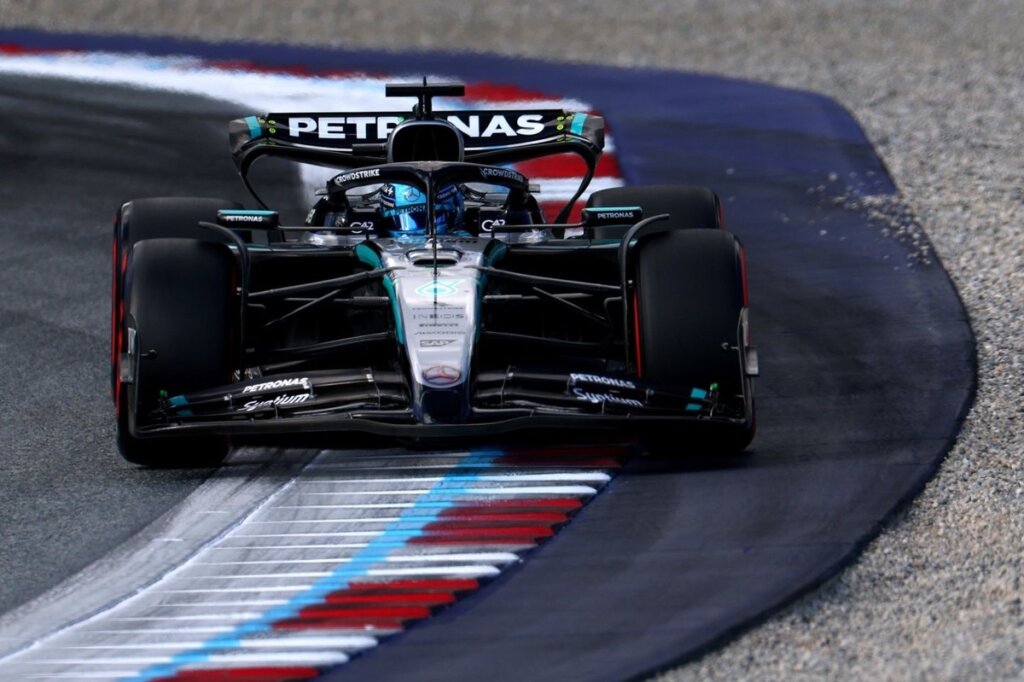Mercedes’ Challenging Weekend at the Austrian GP: Overheating and Set-Up Struggles
Disappointing Results in Austria After Canadian Triumph
Mercedes’s celebration of victory at the Canadian Grand Prix was short-lived, as the team faced a tough race at the Red Bull Ring in Austria. George Russell finished fifth, over a minute behind the leading McLaren drivers, despite aiming for a podium finish after his promising performance the day before. The Austrian race marked what many consider the most difficult weekend of the season for Mercedes, primarily due to persistent tyre overheating issues that had previously affected their performance in other high-temperature races like Jeddah and Imola.
Austria’s race was a stark contrast to Canada’s, with Ferrari also closing the gap, finishing approximately 30 seconds ahead after introducing upgrades that positioned them as the leading “best of the rest.” Russell’s final position was a narrow five-second margin over midfield teams, highlighting the struggles Mercedes faced in keeping pace, especially when compared to Ferrari’s improved pace and reliability.
Throughout the race, Russell was more focused on monitoring his mirrors than aggressively challenging Ferrari, aside from a brief early duel with former teammate Lewis Hamilton. Reflecting on the weekend, Russell admitted, “I anticipated a tough race, but it turned out worse than I imagined. The core issue is clear-after Canada’s success, where tyre overheating was not a problem, we are the fastest. But as soon as the track temperature rises, our performance drops significantly.”
He further explained, “Our team has been working tirelessly for six months to resolve this problem. We have some ideas, but progress has been slow, and we’re not making major breakthroughs right now.”
Beyond Temperature: The Complexities of Tyre Management
Overheating tyres remain the most critical challenge for the W16, but the issue is multifaceted. For instance, during the Canadian GP, track temperatures reached 50°C, yet the softer compounds used there helped mitigate overheating. Conversely, in Austria, the asphalt temperature was similarly high, but the track’s layout and surface characteristics exacerbated the problem.
In Spain, where temperatures also hovered around 50°C, Mercedes managed to stay competitive, finishing within 30 seconds of Ferrari despite using harder tyre compounds. This comparison underscores that the overheating dilemma isn’t solely temperature-dependent but also involves factors like track design and how the car interacts with the tyres.
The Canadian race’s success was partly due to the track’s slow, tight corners, which limited thermal stress on the tyres, preventing the McLaren from fully exploiting its speed. Austria’s circuit, however, presents a different challenge with two distinct sectors: one featuring heavy braking zones and DRS straights, and another filled with high-speed corners that generate significant energy transfer to the tyres, increasing overheating risks.
The Perfect Storm: Qualifying and Race Day Challenges
During qualifying, the W16 demonstrated strong straight-line speed and braking performance, nearly matching McLaren’s pace. However, the car struggled in the long, sweeping corners, especially in Turn 9, where Mercedes faced notable difficulties compared to other top contenders. This was unexpected, as Mercedes had previously shown better long-run consistency on tracks like Imola and Jeddah, where cooler conditions under 40°C revealed different performance patterns.
Long-run data initially suggested promising performance, leading the team to believe they had found a viable setup. However, as track temperatures soared, grip levels increased, and the car’s behaviour changed dramatically. Mercedes’s decision to stick with a setup optimized for cooler conditions proved to be a miscalculation, resulting in overheating and reduced traction during the race.
Mercedes’s unchanged setup from Friday, combined with a 10°C rise in asphalt temperature between qualifying and race day, caused the team to face a crisis similar to Red Bull’s struggles. The overheating not only affected tyre performance but also compromised overall traction, making it difficult to maintain pace and stability on the abrasive Austrian surface.
Team principal Toto Wolff reflected, “Our approach was based on the data from previous races, but the conditions here were different. We tried something extreme, inspired by setups from Montreal and Barcelona, but it didn’t work as expected. If we had relied on last year’s setup, we might have achieved a better result.”
He added, “This weekend’s issues highlight the importance of adaptability and understanding the complex interplay between track surface, car setup, and tyre behaviour. It’s a reminder that racing conditions can change rapidly, and our strategies need to be flexible.”
Experimental Strategies and Future Outlook
Wolff explained that Mercedes deliberately experimented with new setup configurations during the Austrian weekend, aiming to gather data for future races and the upcoming 2026 regulations. Prior to the race, technical director Simone Resta noted that the team’s recent struggles stemmed from a limited setup window, a problem that persisted in Austria as well.
“Our goal was to test some aggressive ideas, even if they didn’t pay off this time,” Wolff stated. “In Montreal, these adjustments showed promise, but here, they backfired. We could have reverted to last year’s setup and perhaps finished on the podium, but we chose to push the boundaries to learn more.”
He emphasized that, while the results were disappointing, the team’s willingness to take risks is part of their development process. “If we were fighting for the championship, this would be a different story. But right now, it’s about understanding and improving for the future,” Wolff concluded.

